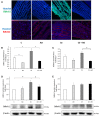Cigarette Smoking-Induced Cardiac Hypertrophy, Vascular Inflammation and Injury Are Attenuated by Antioxidant Supplementation in an Animal Model
- PMID: 27881962
- PMCID: PMC5101594
- DOI: 10.3389/fphar.2016.00397
Cigarette Smoking-Induced Cardiac Hypertrophy, Vascular Inflammation and Injury Are Attenuated by Antioxidant Supplementation in an Animal Model
Abstract
Background: Cardiovascular diseases are the leading causes of morbidity and mortality worldwide. Cigarette smoking remains a global health epidemic with associated detrimental effects on the cardiovascular system. In this work, we investigated the effects of cigarette smoke exposure on cardiovascular system in an animal model. The study then evaluated the effects of antioxidants (AO), represented by pomegranate juice, on cigarette smoke induced cardiovascular injury. This study aims at evaluating the effect of pomegranate juice supplementation on the cardiovascular system of an experimental rat model of smoke exposure. Methods: Adult rats were divided into four different groups: Control, Cigarette smoking (CS), AO, and CS + AO. Cigarette smoke exposure was for 4 weeks (5 days of exposure/week) and AO group received pomegranate juice while other groups received placebo. Assessment of cardiovascular injury was documented by assessing different parameters of cardiovascular injury mediators including: (1) cardiac hypertrophy, (2) oxidative stress, (3) expression of inflammatory markers, (4) expression of Bradykinin receptor 1 (Bdkrb1), Bradykinin receptor 2 (Bdkrb2), and (5) altered expression of fibrotic/atherogenic markers [(Fibronectin (Fn1) and leptin receptor (ObR))]. Results: Data from this work demonstrated that cigarette smoke exposure induced cardiac hypertrophy, which was reduced upon administration of pomegranate in CS + AO group. Cigarette smoke exposure was associated with elevation in oxidative stress, significant increase in the expression of IL-1β, TNFα, Fn1, and ObR in rat's aorta. In addition, an increase in aortic calcification was observed after 1 month of cigarette smoke exposure. Furthermore, cigarette smoke induced a significant up regulation in Bdkrb1 expression level. Finally, pomegranate supplementation exhibited cardiovascular protection assessed by the above findings and partly contributed to ameliorating cardiac hypertrophy in cigarette smoke exposed animals. Conclusion: Findings from this work showed that cigarette smoking exposure is associated with significant cardiovascular pathology such as cardiac hypertrophy, inflammation, pro-fibrotic, and atherogenic markers and aortic calcification in an animal model as assessed 1 month post exposure. Antioxidant supplementation prevented cardiac hypertrophy and attenuated indicators of atherosclerosis markers associated with cigarette smoke exposure.
Keywords: calcification; cardiovascular diseases; cigarette smoking; hypertrophy; inflammation; pomegranate juice; reactive oxygen species.
Figures





References
-
- Akhtar S., Asghar N. (2015). Risk factors of cardiovascular disease in district Swat. J. Pak. Med. Assoc. 65, 1001–1004. - PubMed
-
- Arslan F., Smeets M. B., Riem Vis P. W., Karper J. C., Quax P. H., Bongartz L. G., et al. . (2011). Lack of fibronectin-EDA promotes survival and prevents adverse remodeling and heart function deterioration after myocardial infarction. Circ. Res. 108, 582–592. 10.1161/CIRCRESAHA.110.224428 - DOI - PubMed
LinkOut - more resources
Full Text Sources
Other Literature Sources
Miscellaneous

